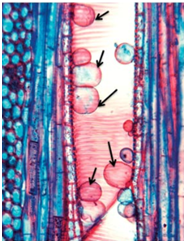The balloon-shaped structures called tyloses
1. are linked to the ascent of sap through xylem vessels
2. originate in the lumen of vessels
3. characterize the sapwood
4. are extensions of xylem parenchyma cells into vessels
The given diagram shows the central core of root in a certain plant. P is phloem and protoxylem elements and V is metaxylem. What is correct for structures indicated by arrows?
1. They show aerenchyma essential for aeration of root cells
2. They show cells in the roots that contain chloroplast
3. They show cells lack the characteristic radial and inner tangential wall thickening which is common to endodermal cells
4. They show cells that store resins and oils in the roots
The balloon like structures seen in vessels in the given diagram are called as:

1. Tyloses
2. Hydathodes
3. P proteins
4. Lenticells
What type of vessels are you most likely to see in metaxylem of a stem?
1. 
2. 
3. 
4. 
The tensile strength of fluid column within a tracheary element is:
1. directly proportional to its diameter
2. inversely proportional to its diameter
3. directly proportional to its length
4. has no relation to the diameter and the length of the tracheary element
Consider the given two statements:
I. Vessel elements are generally thought to be more efficient conductors of water than the tracheids.
II. Vessel elements, with their open systems, are more safe for plants than tracheids.
1. Both I and II are correct and II explains I
2. Both I and II are correct but II does not explain I
3. I is true but II is false
4. Both I and II are false




